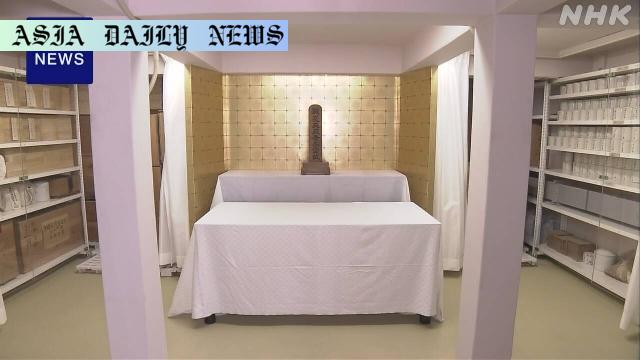Atomic Bomb Memorial: Hiroshima City intensifies its efforts to reconnect 812 unclaimed remains with their families after 80 years.
Hiroshima’s Atomic Bomb Memorial vault showcases remains after a decade.
Efforts intensified to locate relatives of 812 individuals identified.
80th anniversary honors the memory of victims and their families.

Introduction: A Vault of Memories
The Atomic Bomb Memorial Mound in Hiroshima City holds profound historical significance, acting as a solemn reminder of the devastating atomic bombing on August 6, 1945. After a decade, its underground vault has been reopened to journalists, offering a glimpse into a space that houses the remains of about 70,000 victims. Amongst these are 812 identified individuals whose remains, heartbreakingly, remain unclaimed by their relatives. This renewed unveiling marks not only a moment of remembrance but also a call for action to reconnect families with the memories of those lost.
A Restored Memorial Space
The underground vault itself spans a modest 27 square meters. Despite its size, its contents carry immeasurable value: small, labeled urns lined up in rows, each containing the remains of a victim. Over two decades had passed since its last repainting, and now its freshly restored walls and ceiling offer a renewed sense of dignity and care. This meticulous upkeep reflects Hiroshima City’s dedication to preserving the memory of the tragedy and the lives lost, as they honor the victims year after year.
Unclaimed Voices: The 812 Identified
Within the 70,000 individuals, there are 812 whose names are known, yet they remain unclaimed by their families even 80 years after the atomic bombing. Efforts to reconnect these individuals with their relatives have faced significant challenges. Hiroshima City officials have tried various approaches, such as displaying a register of names at municipal offices and making information publicly available on the city’s website. Unfortunately, as the decades pass and memories fade, locating relatives has become a rare accomplishment. Nevertheless, these ongoing efforts exemplify a commitment to ensuring that every name and story is preserved with respect.
A Call to Action and Reflection
As the 80th anniversary of the atomic bombing approaches, the importance of these efforts cannot be overstated. The world must continue to remember the lessons of Hiroshima and honor the lives lost. City officials, led by Uemoto Shinji, have resolved to intensify their search for relatives of the unclaimed victims. While the task is daunting, the dedication shown by the Hiroshima City team resonates deeply, serving as a reminder that history is not just about the past—it is also about nurturing connections in the present and preserving them for the future generations.
Lessons from Hiroshima
The Atomic Bomb Memorial is not just a resting place for remains, but a beacon of history, remembrance, and resilience. It stands as a potent reminder of the horrors of nuclear warfare and the irreplaceable value of peace. As generations move forward, it is crucial that these memories and lessons are carried on, ensuring that atomic tragedies never repeat. The vault’s unveiling, tied with the city’s efforts, underscores the importance of maintaining our collective humanity while honoring those who suffered unimaginable losses during a catastrophic event.
Through this story of remembrance and rediscovery, the Atomic Bomb Memorial Mound serves not only as a symbol of hope and resilience but also as an unyielding testament to the endurance of human connections and the enduring responsibility to remember and learn from the past.



Commentary
Reflecting on Hiroshima’s Legacy of Memory
The recent unveiling of the underground vault at Hiroshima’s Atomic Bomb Memorial Mound stirs a mix of solemnity and admiration. As a powerful repository of human history, this site not only commemorates the catastrophic loss of life but also conveys an enduring message of peace and hope for a better future. The careful restoration of the vault’s walls and ceilings after 20 years speaks volumes about the importance placed on preserving memories with dignity and respect. As we move forward in time, maintaining tangible reminders of the past becomes an increasingly vital task, particularly for events that shaped the course of history.
Challenges of Reconnecting Across Time
The effort to locate families of the unclaimed victims highlights the complexities of memory and loss over generations. While the identities of 812 individuals are known, tracking down their relatives 80 years after the tragedy is no small feat. Aging witnesses, fractured family trees, and the vast passage of time have all added to the challenge. Yet, Hiroshima City’s persistence in searching for these families reflects a deep moral commitment to honoring each individual victim. It’s a calling dedicated to reconnecting lives that were torn apart under extreme circumstances, a task that resonates with resilience and humanity.
Lessons to Carry Forward
There is a profound lesson to be drawn from the ongoing efforts in Hiroshima. The memory of the Hiroshima bombing is not solely about historical facts or figures—it is a visceral reminder to value peace, respect human life, and avoid repeating the same mistakes. It is heartening to see such dedication in preserving these lessons. Moreover, it is our collective responsibility to ensure that the harrowing stories of those who perished, and those who survived, continue inspiring future generations to work toward a more peaceful world.
Hiroshima’s efforts to maintain the legacy of the Atomic Bomb Memorial Mound remind us that while time moves forward, the lessons of history must not be forgotten. It is an enduring message for us all to cherish peace, remember the lives lost, and strive for a future where such tragedies never recur.